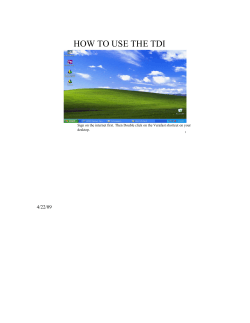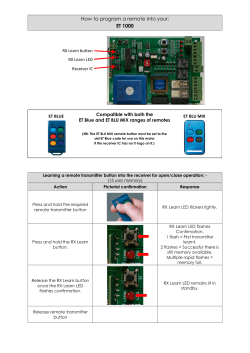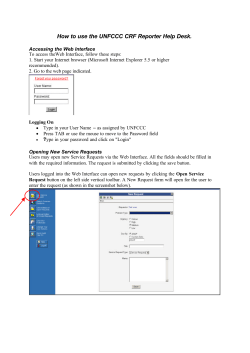
IX2D-GM Tutorial How to import and interpret gravity and magnetics data using IX2D-GM
IX2D-GM Tutorial Version 1.00 How to import and interpret gravity and magnetics data using IX2D-GM © 2010 Interpex Limited Import & Interpretation Sequence Use File/New/Clear Data if you want to start with a clean project. Use File/New/Profile/Gravity Profile to enter new data into spreadsheet. (or File/New/Profile/Magnetics Profile) Or Use one of the File/Import options to import data from FLAT ASCII, XYZ or MAGIX MGX files Use the mouse to enter a 2-D model of the section or import bodies and layers from ASCII files. Use Calculate/Forward to generate a forward curve from the model. Use the mouse to move vertices and bodies or use Calculate/Inverse…to improve the fit between synthetic and data. Adjust colors, add labels and export the graphic Use File/New/Profile/Gravity (or Magnetics) Profile. First, select array type, units for distance and density or susceptibility and other parameters. Use data editor to enter new data. Second, enter data into spreadsheet and change Data Set Name. If data are in Excel, Open XLS file. Third, if data are in XLS or some other spreadsheet format, open the file in the spreadsheet and select the data to be copied. Right click in the selection and select Copy or just press ctrl-C to copy the data to the clipboard. Paste the data into IX2D-GM Position the focus on the top left cell and right-click. Then select Paste. Or just press ctrl-V to paste the data. Edit the data if needed and press OK Once the data are pasted into the XI2D-GM data editor, you can make modifications, change the name and then press OK to see the data graph. A message appears if you forget to change the name. Data and Topography are Loaded Initial graph just shows data and topography values Save the database as a project Use the File/Save or toolbar button in the main map window to save the database after loading each profile. You can load several profiles into the same database project. Import data from a MGX ASCII or XYZ file. ASCII and XYZ files have columns containing data, including easting and northing coordinates, station (profile coordinate), elevation and data values. XYZ files have LINE keywords containing the line name and thus can contain more than one profile line. MAGIX binary MGX and ASCII MAG data files have specific proprietary formats which can be read. MGX files contain both data and model information. Use File/Import/Gravity (or Magnetics) Data. First, select array type, units for distance and density or susceptibility and other parameters. Press OK to select file for import. Select Columns for Import. Columns are available for reading easting, northing, elevation, station and data. This example has no column for elevation, so we set that to zero. There is also no separate column for station, but this is the same as easting, so we set that to 1. We can attempt to read all rows – the first two will be skipped. Interpreting the Data 1. 2. 3. 4. 5. 6. 7. Decide on what sort of model you want to use based on your knowledge of the geology of the area and the data. Adjust the model display to allow for entry of the starting model. Enter the bodies and layers you have chosen to use. Carry out a forward calculation. Adjust the model using the mouse, moving vertices and bodies, changing body parameters. Decide what to use as inversion parameters and set them. Perform an inversion and cycle through 5-7 until satisfied. For potential field data, there is no reliable way to automatically generate an interpretation. We need to start with a geological concept and create a starting model by drawing in the layers and bodies we think might exist, estimating their physical properties and refining them later. Designing the Starting Model These data were taken over a valley with low-density fill. There is a bump in the center which may mean the presence of a denser body. We will perform the interpretation starting with that concept. Adjusting the Model Display If we are entering layers, we may want to expand the horizontal extent of the display. This could be done by changing the starting point of the profile to -5 and increasing the number of major divisions from 5 to 7. We would certainly want to extend the depth so we have more space to enter layers and bodies. This could be done by decreasing the starting point to -2, increasing the increment to 1 and increasing the number of major divisions to 5. There are two ways to adjust the model display. One is to use View/Properties and manually enter the desired axes. The second is to use the zoom tool to zoom the display outwards to achieve the desired scaling. The Apply button in the View/Properties dialog can be used to test each change. Adjusting Model Display with Zoom Tool Depressing the left mouse button in the upper left corner and dragging to the lower right corner allows us to draw a box which will be used to rescale the axes. This can be done repeatedly until we are satisfied with the display. Display Ready for Model Entry In either case, using the View/Properties or the interactive Zoom tool, we can adjust the display to allow for the required entry of layers and bodies. This can be readjusted later as well. Starting the Model Entry Since we want a valley with low density, we begin by right-clicking in the background and selecting Edit Background Properties. This brings up the Edit Background dialog. Enter -.25. OK Starting First Layer Entry We start the first layer entry by right-clicking in the model display and selecting New Layer. A dialog appears allowing us to control the entry of the new vertices in the new layer. Entering Layer Enter the vertices from left to right. Try to mimic the shape of the gravity field. Then press Finish to display the dialog requesting density. Enter zero for the density contrast below the interface (contrast above it is background and is -0.25). Then the layer is complete. Use Forward to see results Use Calculate/Forward or the toolbar button to see the result. It is apparent that we need to move the vertices near distance 20 to the right to better match the peak in the data. Move Vertices to Improve Fit Pointing at a vertex turns the cursor to a crosshair. Depress the left mouse button and move the vertex. Watch the synthetic curve change as you move. Release the button to complete the edit. Add Body to Fit Bump Right-click in the model while not inside a body or layer and select New Body. This brings up the Vertex Insertion dialog. Enter Vertices and Press Finish Click on desired vertex locations. Body can be entered clockwise or counterclockwise. Click the Finish button on the dialog when finished. Then use Forward to see new synthetic curve. Move Body to Improve Fit Point at one of the vertices on the new body, depress the right mouse button and drag the body to a new location to improve the fit. Next we will use the inversion. Performing Inversion for Best Fit 1. 2. 3. 4. 5. 6. 7. Use right-drag to free most vertices on the layer in the vertical direction. Use right-drag to fix all body vertices in the vertical direction. Lock the body vertices together. Free the leader vertex on the body in both directions. Perform the inversion. Decide what to use as inversion parameters and set them. Perform an inversion and cycle through 5-7 until satisfied. We desire to have the automatic inversion find the best fit. We do this by allowing most layer vertices to move vertically and by allowing the body to move about in both directions. Free Vertices for Vertical Movement Using the right mouse button, drag and draw a box around the vertices to be freed and select Free Z Movement from the menu that appears when the button is released. Fix Vertical Movement for Body Unfortunately, this also frees the vertices in the body. We could have moved the body out of the way first, but it is just as easy to select these vertices and fix the vertical movement. Lock Body Together Right click inside the body and select Lock Body from the pop-up menu. Free the Leader Vertex on the Body Right click on the Leader of the body, which is vertex number 1 at the top. Select Free X Movement. Right click on it again and select Free Z movement. Now the body is free to move in either direction. Ready for Inversion Use the Single Inversion Iteration toolbar button as shown above or the menu command Calculate/Inverse…/Single Iteration as shown in the inset to perform one iteration of inversion. Inversion – 4 iterations The inversion eventually reduces the fitting error from 1.4 mgal to 0.3 mgal. Final Inversion Result after Model Rescale Use View/Unzoom Model or the toolbar button to rescale the model. If the results are not satisfactory, you can manually adjust the model and repeat the inversion until you get a satisfactory result. Color Fill Display Use View/Color Fill Properties to control the parameters for density/susceptibility color fill. Use the hotkeys or View menu check items to view/hide vertices, free vertices, locks or labels. Color fill parameters are global and applies to all profiles. They are stored in the .INI configuration file. Add Labels for Density/Susceptibility Right-clicking on the model display allows you to change the model view and some of the view properties. New Label allows you to add a text label. Right-click while inside a body or layer to label the density or susceptibility. Right-clicking in the background allows you to label the background. Right-clicking in the air allows you to add a text label. Label Body allows you to add a density or susceptibility label. Body labels show the density of the label center (if no arrow) or the arrow point (with arrow), even if the label is later moved. Edit Labels – Move or Resize Pointing at a label or a label arrow tip draws a box around the label and draws the arrow in a different color if there is an arrow. Pointing inside a label or at an arrow tip allows you to move the label or tip. Point at a label to light it up. The cursor will change when you are pointing at a label. Press the left button and drag to move or resize. Right-click on the label to edit text, delete label or add/delete arrow. You cannot edit the text on body labels – they show the property at the arrow tip or center of label. Pointing at a corner or edge allows you to move the corner or edge to resize the label.
© Copyright 2025





















